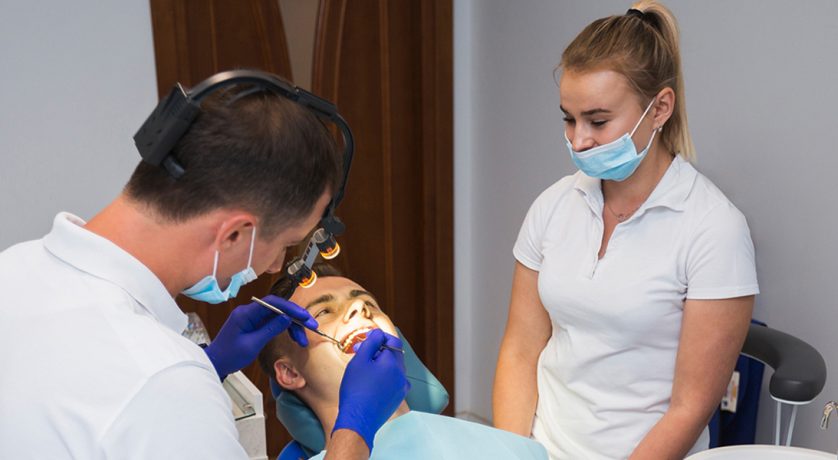Can Your Dentist Repair Large Cavities with Inlays or Onlays?
August 12, 2025
Understanding Large Cavities
When we say “large cavity,” we’re talking about serious damage. This isn’t just a dark spot on your molar. These cavities affect how your tooth works and holds up under pressure.
Here’s what causes large cavities:
- Skipping routine dental visits
- Poor brushing or flossing habits
- High-sugar diets
- Dry mouth or reduced saliva flow
- Genetics and enamel weakness
As decay spreads deeper into the tooth, the structure weakens. Eventually, the cavity becomes too big for a regular filling, but not so bad that a crown is the only option. That’s when your dentist may suggest something smarter.
Why Traditional Fillings Might Not Be Enough
For small cavities, fillings work fine. But once the damage covers a significant portion of the tooth, you’re asking too much of a simple filling.
Here’s why fillings might fail:
- Not enough support for biting pressure
- More prone to cracking or falling out
- May lead to repeated replacements
- Increases the risk of future root canals
Fillings just aren’t built for the long haul when the tooth is deeply compromised. If you’ve needed more than one filling on the same tooth, or it hurts every time you chew, it’s time to consider other options. Ask your dentist in Jacksonville if your tooth needs stronger reinforcement.
What Are Inlays and Onlays?
Inlays and onlays are custom-made restorations that fill in where decay has taken over, but without covering the whole tooth like a crown. They’re often called “indirect fillings” and are made in a lab, not placed directly in your mouth like regular ones.
Inlays
- Fit within the grooves of your tooth
- Do not touch the outer edges
- Replace the central chewing area
Onlays
- Extend to the edges and cover one or more cusps
- Strengthen the biting surface
- Offer broader coverage than inlays
Both are made from durable materials like porcelain, composite resin, or gold. Each piece is crafted to match your tooth’s natural shape and color.
Benefits of Using Inlays and Onlays for Large Cavities
So, what makes these options better than fillings or even crowns for certain situations?
Top benefits include:
- Durability: Stronger and longer-lasting than traditional fillings
- Natural appearance: Blend in seamlessly with your existing teeth
- Tooth preservation: Less drilling compared to crowns
- Custom fit: Created just for your tooth using scans or impressions
- Long lifespan: Can last 10–30 years with good care
If you care about function, comfort, and looks, inlays or onlays hit that sweet spot. They restore your tooth’s strength while keeping your natural structure intact.
The Treatment Process: From Decay to Restoration
The process is straightforward and usually completed in two visits. It’s nothing to stress over, even if you’ve never had anything beyond a filling.
Here’s how it works:
- Consultation and Exam
Your dentist checks the size and location of the cavity. X-rays or digital scans help create an exact model.
- Tooth Preparation
The decayed part of the tooth is removed and shaped to receive the inlay or onlay.
- Impressions and Lab Work
A mold or scan is sent to the lab. You’ll get a temporary piece while your custom restoration is made.
- Final Placement
The inlay or onlay is fixed to your tooth with high-strength dental cement. After a polish, you’re good to go.
With minimal recovery time and no food restrictions after the bonding sets, it’s a pretty smooth fix, especially compared to full crowns.
When Are Inlays or Onlays Recommended Instead of Crowns?
Crowns are often thought of as the go-to fix for broken teeth. But they require shaving down your tooth quite a bit.
You may be better off with an inlay or onlay if:
- The damage is significant but not full-blown
- You want to save more of your natural tooth
- You’re looking for a less invasive and more affordable option
In many cases, these restorations offer the strength of a crown, without the commitment. They’re especially useful for molars that take on a lot of pressure but don’t need full coverage.
How to Know If You’re a Good Candidate
Not sure if inlays or onlays are right for you? That’s okay. The dentist near you will evaluate a few key things first.
Factors your dentist will consider:
- Size and location of the cavity
- Strength of the surrounding tooth structure
- Your bite and alignment
- Oral hygiene habits
You may not be an ideal candidate if:
- The tooth is too decayed or infected
- You grind your teeth at night (bruxism)
- The cavity reaches beneath the gum line
But if you’ve recently cracked a filling or need urgent relief, ask your emergency dentist about a fast and lasting solution.
Final Thoughts
Inlays and onlays bridge the gap between minor repairs and full crowns. They offer strength, beauty, and longevity, especially when cavities get out of hand. if you’re not sure what your tooth needs, don’t wait.
Amiable Dental Care is here to help. Book a consultation today and see if Inlays & Onlays in Jacksonville, FL are your best fit. Your stronger smile is one visit away.
